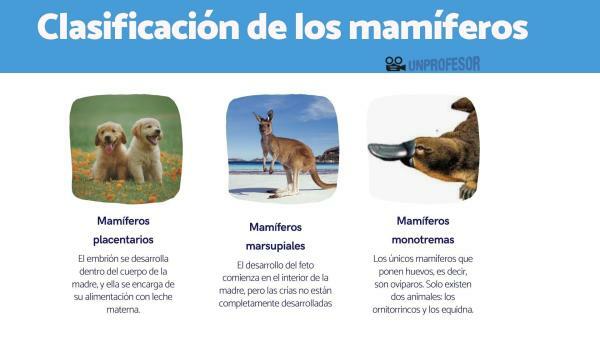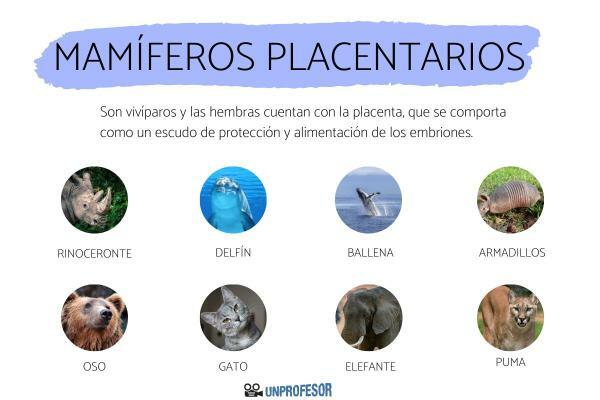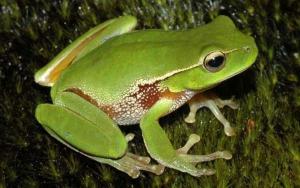WHAT ARE PLACENTAL MAMMALS?

The mammals They are a group of vertebrate animals that are characterized by having fur, because they are born from the mother's womb and because the young feed on milk through the mammary glands. If you stop to think, you and I are mammals. But what do a lioness from the savannah and your neighbor from the 4th floor have in common? The answer is that there are many types of mammals and today we are going to show you one of them.
In this lesson from a TEACHER, we want to bring you closer to the heart of the wildest nature, to explain in detail what are placental mammals and everything you need to know about them. Let's go there!
Index
- What are placental mammals?
- Placental Mammalian Groups
- Examples of placental mammals
- Characteristics of placental mammals
What are placental mammals?
Mammals are divided into three large groups, taking into account the way in which they give birth to their young:
- The Metatheria (marsupials), where we find kangaroos
- The Prototheria (monotremes), the group to which the platypus and other egg-laying mammals
- The placentalia (placentals).
These three groups reach, together, more than 5,100 species different from mammals.
placental mammals they are viviparous and they are also known simply as placental animals.
The females of placental animals have a morphological structure inside their bellies called placenta and behaves as a shield for the protection and feeding of the embryos, during their gestation period, that is, the pregnancy.
He gestation time of the embryos varies according to the species, although it is usually longer in large mammals and shorter in small ones. For example, the gestation process for mice lasts approximately 21 days and for elephants it takes 2 years.
In unProfesor we discover the classification of mammals.

Groups of placental mammals.
In all there are 18 different placental animal groups, classified taking into account the genetic results of the species:
- cingulates
- hairy
- tubulidentates
- macrocelids
- hiracoid
- proboscideans
- sirenians
- eulippothiphanes
- bats
- folidotos
- Carnivores
- perissodactyls
- cetaceans
- artiodactyls
- lagomorphs
- rodents
- scandentians
- primates
Examples of placental mammals.
Now we are going to put some examples of placental mammals and its name in Latin. Could you tell which group of the previous classification they belong to? If you don't know any of them, we encourage you to search for their definition in an encyclopedia or find a photo on Google:
- Indian rhinoceros (Rhinoceros unicoris)
- Amazon pink dolphin (Inia geoffrensis)
- Humpback or humpback whale (Megaptera novaeangliae)
- Orca (Orcinus orca)
- Armadillos (family Dasypodidae)
- Mexican anteater (Tamandua mexicana)
- Giant anteater (Myrmecophaga tridactyla)
- Sloth (Bradypus tridactylus)
- Linnaeu's two-toed sloth (Choloepus didactylus)
- Hedgehogs (family Erinaceinae)
- Mediterranean water shrew (Neomys anomalus)
- Cabrera Shrew (Neomys anomalus)
- Common bat (Pipistrellus pipistrellus)
- Common vampire bat (Desmoudus rotundus)
- Hairy-footed bat (Diphylla ecaudata)
- White-winged bat (Diaemus youngi)
- Chinese pangolin (Manis pentadactyla)
- Malayan pangolin (Manis javanica)
- Giant pangolin (Manis gigantea)
- Dog (Canis lupus)
- Domestic cat (Felis silvestris catus)
- Snow leopard (Panthera uncia)
- Wolf (Canis lupus)
- Tiger (Panthera tigris)
- Cheetah (Acinonyx jubatus)
- Jaguar (Panthera onca)
- Cougar (Puma concolor)
- African aardvark (Orycteropus afer)
- Cape elephant shrews (Eephantulus edwardii)
- Bruce's hyrax (Heterohyrax brucei)
- African bush elephant (Loxodonta africana)
- Indian elephant (Elephas maximus indicus)
- Manatee (Trichechus inunguis)
- Common mole (Talpa europaea)
- Star-nosed mole (Condylura cristata)
- common zebra (Equus quagga)
- Brown rat (Rattus norvegicus)
- House or common mouse (Mus musculus)
- Bamboo or tupaya squirrel (Anathana ellioti)
- Human being (Homo sapiens sapiens)
- Bornean oragutan (Pongo pigmaeus)
- Gorilla (Genus Gorilla)
- Bengal loris (Nycticebus bengalensis)
- Giraffes (Giraffa camelopardalis)
- American bison (Bison bison)
- Deer (family Cervidae)
- Mountain goat or Iberian ibex (Capra pyrenaica)
- Rabbits (genus Oryctolagus)
- Guinea pig or guinea pig (Cavia porcellus)
- Hares (genus Lepus)

Characteristics of placental mammals.
Although placental mammals are part of very diverse groups, there are certain shared characteristics, in addition to the placenta in which the fetus develops. We explain the characteristics of placental mammals!
- The females are put in zeal, a periodic cycle in which they are able to fertilize.
- He skull of placental mammals it is synapsid, that is, it has a pair of openings into which the jaw muscles are inserted.
- The feeding of placental mammals is very varied and depends on the group to which they belong. That means they can be carnivores (they eat meat and have teeth adapted for it), herbivores (they feed on vegetation), insectivorous (they eat small invertebrates) u omnivores (they eat both animals and vegetables).
- The offspring of these animals have about milk teeth during the first part of his life, to later exchange them for the final adult dentition.
- mammals have sweat glands in various parts of the body, which differentiates them from all other animals that exist. The glands can be ecrines (secrete sweat) or apocrine (present in area with hair).
- At some stage of their development, hair appears, which can be of two types: bob hair (insulators) or bristle hair (for protection). The hair of these mammals is of epidermal origin and is built by a protein called keratin. Some placentals have whisker-adapted hairs, which are sensory hairs that provide animals with tactile sense.
- The mammary glands produce milk to feed the young and are the ones that give their name to the group of mammals. The milk that babies drink is composed of very effective fats and proteins, which allow development and growth in the initial stage of life.
- The skin of each species of animal is adapted to the living conditions it leads. Claws, fingernails, and hooves are also made up of keratin. Some animals have antlers or horns made of the same material.
We hope this lesson has helped you understand a little better what are placental animals and how the gestation of their young works. If you want to continue learning about the secrets of the animal kingdom, do not hesitate to consult our biology section.

If you want to read more articles similar to Placental mammals - with examples, we recommend that you enter our category of biology.
Bibliography
- SERA, A. m. (2022). Why are placental mammals more diverse than marsupials? Biology Meetings.[Internet] Download date, 14-05.
- Duke Osorio, J. F., Ortiz Salazar, M. A., Salazar Monsalve, L., & Mejía Pavony, C. TO. (2009). Mammals: Evolution and dental nomenclature.



